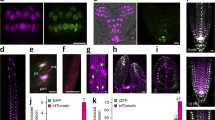Abstract.
We have constructed transgenic Arabidopsis lines that contain a gene for green fluorescent protein (GFP) under the control of auxin-responsive domains A and B of the promoter from the pea PS-IAA4/5 gene. The chimeric transgene was named BA-mgfp5-ER. GFP was detected after the application of indole-3-acetic acid at concentrations as low as 100 nM in epidermal cells in the root elongation zone. The induction of the reporter gene was highly specific to auxin and was correlated with the auxin-induced change in epidermal cell shape. No GFP accumulation was observed in the lateral root meristem that was formed as a result of exogenous auxin application. These results suggest that auxin signals were transmitted through several distinct pathways depending on the cell type. The intensity of the GFP signal was strong enough to be observed through the plastic lid of the culture dish using a dissecting microscope, thereby enabling GFP expression to be monitored in an aseptic environment. Thus, the BA-mgfp5-ER transgenic plant can be a powerful tool for screening mutants that are defective in auxin signaling and the expression of early auxin-response genes.
Similar content being viewed by others
Author information
Authors and Affiliations
Additional information
Electronic Publication
Rights and permissions
About this article
Cite this article
Aspuria, .E., Ooura, .C., Chen, .G. et al. GFP accumulation controlled by an auxin-responsive promoter as a non-destructive assay to monitor early auxin response. Plant Cell Rep 21, 52–57 (2002). https://doi.org/10.1007/s00299-002-0484-6
Received:
Revised:
Accepted:
Issue Date:
DOI: https://doi.org/10.1007/s00299-002-0484-6




